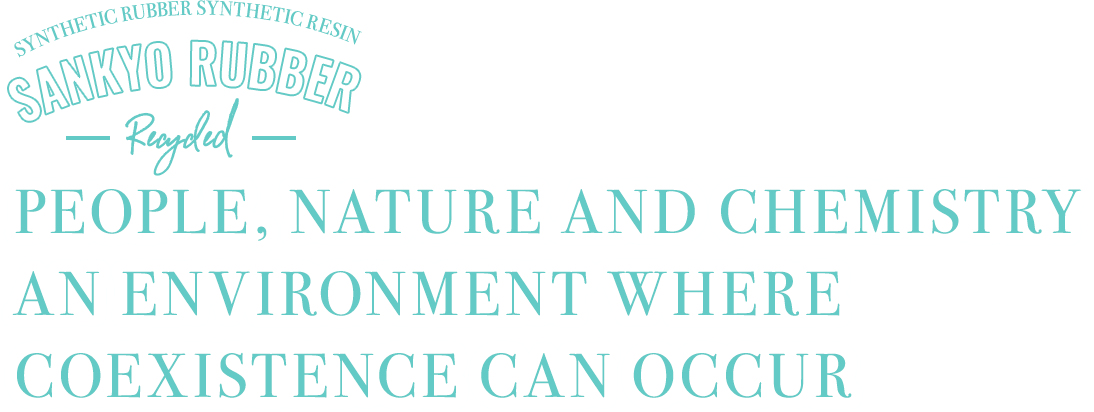Business Description
Transporting and Sales
Dealing with Synthetic Rubber・Synthetic Resin・Natural Rubber・Ruber Powder・Recycled Rubber・Rubber-processed Products(Rubber Powder)(Pasted Rubber)(CMB) etc.
BR
BR is a rubber material produced from the Butadiene solution-polymerization.
BR
BR is a rubber material produced from the Butadiene solution-polymerization. This rubber is more resistance than natural rubber in cold, friction and impact. It's classified into high CIS type(more than 94%) and low CIS type(less than 52%) according to the difference of a polymerization catalyst. High CIS type is exellent in roll processability and used for tires of an automobile, a sole of shoe, a vibrating bumper and etc, on the other hand, low CIS type is exellent in a vulcanization flatness and used for tires of an automobile, a hose, a conveyor belt and etc.
SBR
SBR is a typical synthetic rubber which is copolymerization of Styrene and Butadiene.
SBR
SBR is a typical synthetic rubber which is copolymerization of Styrene and Butadiene.
SSBR
SSBR is produced by a solution-polymerization process.
SSBR
SSBR is produced by a solution-polymerization process. This production has increased for high performance materials such as a tire and rolling resistance and high grip.
NBR
NBR is a synthetic rubber which has outstanding oil resistance, copolymer of Acrylonitrile and Butadiene.
NBR
NBR is a synthetic rubber which has the biggest characteristic of oil resistance, copolymer of Acrylonitrile and Butadiene. NBR is used in some parts such as hoses and gaskets touched fuel and oil. It is classified from extra high ACN level to low ACN level.the higher ACN, the more resistance in oil and the lower ACN, the more resistance in cold.
CR
CR is one of the synthetic rubbers for a general use in special rubbers.
CR
CR is one of the synthetic rubbers for a general use in special rubbers which has high resistance in Ozone, heat,oil, and chemical. It's roughly classified into 4 types which are sulfur modified group, sulfur un-modified group, high cristallization and the others special group.
EPDM
EPM is a copolymerization of Ethylene and Propylene including a little value of third constituent.
EPDM
Ethylene Propylene Rubber is classified into EPM and EPDM. EPM is a copolymerization of Ethylene and Propylene and EPDM is a sulfur vulcanizable terpolymerization which is EPM added third constituent of nonconjugated diene. EPDM has high resistance in weather and a mechanical property, therefor it's used widely for industrial rubber products such as parts for an automobile, wether strips and rubber chips for laying.
IR
IR is which has the same molecular structure of Natural Rubber nature.
IR
IR is a copolymer Isoprene and high which is CIS Polyisoprene that is the same nature as molecular structure of Natural Rubber. Compared to Natural Rubber, EPM is less tensile and tear strength, on the other hand, it has great rebound resilience uniformity of quality less gelation and impurity. The usage of IR is the same way of Nature Rubber widely for tires of an automoble, the sole of a shoe and a conveyor belt.
IIR
IIR is a synthetic rubber which has unique charactalistics like a gas impermeability.
IIR
IIR is a synthetic rubber, a copolymer of Isobutylene with a little volume of Isoprene and it has the biggest unique charactaristics which is gas Impermeability and also has a resistance to weather and an electric insulation. There are 2 kinds of IIR improved a high rate of vulcanization which are CIIR(Chlorobutyl) and BIIR(Bromobutyl) halogened a normal IIR. The main utilities are an antivibration rubber, an adhessives, sealants, etc.
Products Information Elastomers※SBS,SIS,SEBS,POE,TPE, and others are synthetic resin.
SBSHeterophasic Copolymer
Styrene-Butadiene-Styrene block copolymer
SBS Heterophasic Copolymer
SBS is a block copolymer derived from styrene and butadiene.
SBS is used in wide range of fields as a Styrene-based thermoplastic elastomer resin, and also excellent in rubbery property, compatiblity with synthetic resin and mouldability.
SISThermoplastic Elastomer
Styrene-Isoprene-Styrene block copolymer
SIS Thermoplastic Elastomer
SIS is a thermoplastic elastomer (also known as base polymer for adhesives) which contains polyisoprene and polystyrene block structures.
SEBSThermoplastic Elastomer
Styrene-Ethylene-Butylene-Styrene block copolymer
SEBS Thermoplastic Elastomer
Styrene-based thermoplastic elastomer composition. This rubber shows elasticity in extensive temperature range. On the other hand, it become mouldable by getting heat as plastic could be. This rubber is excellent in heat, weather, chemical resistance and electric insulation performance.
POEα-Olefin Copolymer
POE is an α-olefin copolymer which is either noncrystalline or low crystalline.
POE α-Olefin Copolymer
POE is an α-olefin copolymer which is either noncrystalline or low crystalline. Used in wide range of fields as resin improveants which are able to improve properties of resin dramatically.
TPEThermoplastic Elastomer
Thermoplastic olefinic elastomer(TPE) has flexibility as vulcanized rubber. Adaptable to various methods of moulding.
TPE Thermoplastic Elastomer
Thermoplastic olefinic elastomer(TPE) has flexibility as vulcanized rubber. Adaptable to various methods of moulding. This rubber is well known as having wide hardness distribution. Moreover, it has a property of the lightness and low density in comparison with other flexible resins.
PEPolyethylene (LDPE, LLDPE, HDPE)
PE is a synthetic resin, produced from ethylene.
Polyethylene (LDPE, LLDPE, HDPE)
PE is a synthetic resin, produced from ethylene and also as known as typical thermoplastic synthetic resin
EVAEthylene-vinyl acetate copolymer
EVA is a copolymer, consist of ethylene and vinyl acetate.
EVA Ethylene-vinyl acetate copolymer
EVA is a copolymer, consist of ethylene and vinyl acetate. This rubber has excellent low-temperature toughness (Being flexible even at around -50℃ ), weather resistance (against UV radiation and high-temperature) and stress cracking resistance.
PPPolypropylene
PP is a synthetic resin, produced from propylene.
PP Polypropylene
PP is a synthetic resin, produced from propylene. Typical synthetic resin. It is a glossy light material, having strong resistance against heat and chemical.
PSPolystyrene (GPPS) (HIPS)
PS is a plastic resin, produced from polystyrene.
PS Polystyrene (GPPS) (HIPS)
PS is a plastic resin, produced by polymerizing styrene monomers which made from naphtha of crude oil. There are mainly two types of polystyrene GPPS and HIPS. GPPS is general-purpose polystyrene which is high transparency hard material. HIPS is high-impact polystyrene improved by combining with rubber ingredients, having milky white appearance.
POMPolyacetal
Polyacetal is a crystalline thermoplastic resin.
POE Polyacetal
Polyacetal is a crystalline thermoplastic resin, called Acetal copolymer. Mainly be produced from trioxane of formaldehyde trimer.
Corporate Profile
| Trade Name | Sankyo Rubber Co., LTD. |
|---|---|
| Establishment | December 23, 1968 |
| Capital | 80 million yen |
| Employees | 20 |
| Head office | SURUGADAI FUJI VIEW BLDG. 3F, 2-9-12, Kandasurugadai, Chiyoda-ku, Tokyo 1010062 JAPAN TEL.+81-3-5801-6632 FAX.+81-3-5801-6631 E-mail. sankyorubb@sankyo-rubber.co.jp |
| Factory | Sankyo Rubber Co.,Ltd.Kanuma Factory |
| Branch | Sankyo Rubber Co.,Ltd.Singapore Branch |
| Related company | SAP Co., Ltd. SANKYO RUBBER America Inc. Huizhou Sankyo Industrial Co., Ltd. |
| Executives | Koji Fujihira, President |
| Core Businesses | Sales of Rubber Material, Synthetic Rubber Material, Synthetic Resin, Rubber Crumb, Chip, Urethane Resin, and Reclaimed Rubber Material Sales of Exported/Imported Products |
History
| Dec.1968 | Shigeru Fujihira establishes Sankyo Rubber Co., Ltd. with paid-in capital of 3 million yen |
|---|---|
| Apr.1978 | Head office was established at 2-26-11, Nishiarai Honcho, Adachi-ku, Tokyo |
| Nov.1988 | Company reorganized the structure of Office and increased the paid-in capital to 10 million yen |
| Aug.1995 | Paid-in capital increased to 20 million yen |
| Mar.2004 | Paid-in capital increased to 30 million yen |
| Apr.2005 | Head office relocated to a new office built at SG Bldg.,7-21-3,Nishiarai,Adachi-ku,Tokyo |
| May2006 | Paid-in capital increased to 50 million yen |
| Jul.2007 | ISO14001 Certification acquired |
| Jul.2009 | The Joint venture in china, Huizhou East Year Sankyo Industrial Co., Ltd., established |
| Nov.2010 | Sankyo Rubber Thailand Co.,Ltd. Established |
| Jul.2012 | Sankyo Rubber Korea Co.,Ltd. Established |
| Feb.2013 | Sankyo Rubber Co., Ltd. Singapore Branch Established Decided to move ASEAN base to Singapore and closed Thai branch at the same time as opening Singapore branch |
| Apr.2014 | Changed the name of the joint venture "Huizhou Dongsang Sankyo Co., Ltd." to the joint venture "Huizhou Sankyo Industrial Co., Ltd." |
| Oct.2015 | Sankyo Rubber Korea Co.,Ltd. Closed |
| Mar.2018 | SANKYO RUBBER America Inc.Established |
| Dec.2019 | Koji Fujihira assumed the position of president |
| Mar.2022 | Paid-in capital increased to 80 million yen |
| Apl.2023 | Established reprocess factory in Kanuma City, Tochigi Pref. |
| Nov.2023 | Relocate the head office to SURUGADAI FUJI VIEW BLDG. 3F, 2-9-12, Kandasurugadai, Chiyoda-ku, Tokyo |


